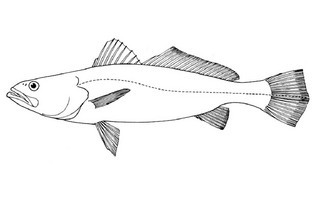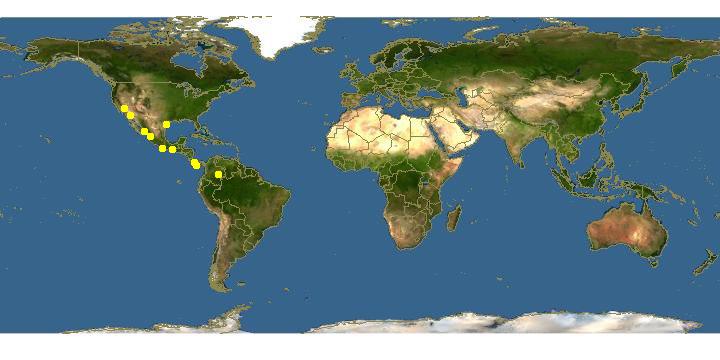
www.fao.org Copyright Michel Lamboeuf · 0
Cynoscion xanthulus |

Click on map for details about points.
|
| Links |
We parsed the following live from the Web into this page. Such content is managed by its original site and not cached on Discover Life. Please send feedback and corrections directly to the source. See original regarding copyrights and terms of use.
- FishBase
|
|
español |
|
|
Overview |
Main identification features
- d: x
- c: blunt point
- pectoral narrow, short
- scales: body rough, head smooth
- dorsal and anal fins- low scale sheath
Dorsal rays IX + I, 19-20, fourth dorsal spine the longest; anal rays II, 8-9; pored lateral-line scales 58-68; gill rakers short and thick, 8-10 on lower limb of first arch, 12-14 in total; head elongate, compressed; snout pointed; mouth oblique, lower jaw projecting beyond upper jaw; no pores or barbel on chin; teeth in 1-2 series, a pair of moderately large canines at tip of upper jaw; margin of preopercle without serrations; pectoral fins short, not reaching beyond tips of depressed pelvic fins; tail with blunt point, more sharply pointed in young; scales rough on body, smooth on head; soft dorsal and anal fins with low (1-2 scales) scaly sheath; lateral line arched anteriorly, becoming straight at level of anus.
Color silver, bluish on upper back; inside of mouth bright yellow orange; pectoral axil blackish; caudal fin yellow.
Size: grows to 90 cm; 24.6 kg.
Inhabits coastal waters.
Depth: 1-50 m.
Central Baja and Gulf of California to Acapulco, Mexico.
Attributes
Abundance: Common.
Cites: Not listed.
Climate Zone: North Temperate (Californian Province &/or Northern Gulf of California); Northern Subtropical (Cortez Province + Sinaloan Gap); Northern Tropical (Mexican Province to Nicaragua + Revillagigedos).
Depth Range Max: 50 m.
Depth Range Min: 1 m.
Diet: bony fishes; mobile benthic crustacea (shrimps/crabs); octopus/squid/cuttlefish.
Eastern Pacific Range: Northern limit=32; Southern limit=17; Western limit=-115; Eastern limit=-99; Latitudinal range=15; Longitudinal range=16.
Egg Type: Pelagic; Pelagic larva.
Feeding Group: Carnivore.
FishBase Habitat: Bentho-Pelagic.
Global Endemism: Tropical Eastern Pacific (TEP) endemic; East Pacific endemic; All species.
Habitat: Estuary; Sand & gravel; Soft bottom (mud, sand,gravel, beach, estuary & mangrove); Water column.
Inshore Offshore: Inshore; Inshore Only.
IUCN Red List: Not evaluated / Listed.
Length Max: 90 cm.
Regional Endemism: Continent; Continent only; TEP endemic; Continental TEP endemic; Cortez + Mexican provinces endemic; All species.
Residency: Resident.
Salinity: Brackish; Marine.
Water Column Position: Mid Water; Near Bottom; Bottom; Bottom + water column;
|
|
|
Names | |
|
|
|
Links to other sites | |
|
|
|
References |
- Balart , E. F. , Castro-Aguirre , J. L. and De Lachica-Bonilla, F., 1997., Análisis comparativo de las comunidades ícticas de fondos blandos y someros de la Bahía de La Paz, B.C. S.. En Urbán Ramírez, J. y M. Ramírez Rodríguez (Eds.). La Bahía de La Paz investigación y conservación., Universidad Autónoma de Baja California Sur:177-188.
- Castri-Aguirre, J.L., Espinoza-Pérez, H. and Schmitter-Soto, J.J., 2002., Lista sitemática, biogeográfica y ecológica de la ictiofauna estuarino lagunar y vicaria de México. En: Lozano-Vilano, M. L. (Ed.). Libro Jubilar en Honor al Dr. Salvador Contreras Balderas., Universidad Autonoma de Nuevo León:117-142.
- Castro-Aguirre , J. L. and Balart, E. F., 1997., Contribución al conocimiento de la ictiofauna de fondos blandos y someros de la Ensenada de La Paz y Bahía de La Paz, B.C.S.. En Urbán Ramírez, J. y M. Ramírez Rodríguez (Eds.). La Bahía de La Paz investigación y conservación., Universidad Autónoma de Baja California Sur:139-150.
- Castro-Aguirre, J.L., 1999., Ictiofauna estuarino-lagunar y vicaria de México., Editorial Limusa S.A. de C.V.: 1-629pp.
- Findley, L.T., Hendrickx, M.E., Brusca, R.C., van der Heiden, A.M., Hastings, P.A., Torre, J., 2003., Diversidad de la Macrofauna Marina del Golfo de California, Mexico., CD-ROM versión 1.0. Projecto de la Macrofauna del Golfo . Derechos reservados de los autores y Conservación Internacional.
- Fischer , W. , Krup , F. , Schneider , W. , Sommer , C. , Carpenter , K. E. and Niem, V. H., 1995., Guia FAO para la Identificacion de Especies de para los fines de la Pesca. Pacifico Centro-Oriental. Volumen III. Vertebrados - Parte 2., FAO3:1201-1813.
- Galván-Magaña, F., Gutiérrez-Sánchez, F., Abitia-Cárdenas, L.A., Rodríguez-Romero, J., 2000., The distribution and affinities of the shore fishes of the Baja California Sur lagoons. In Aquatic Ecosystems of Mexico: Status and Scope. Eds. M. Manuwar, S.G. Lawrence, I.F. Manuwar & D.F. Malley. Ecovision World Monograph Series., Backhuys Publishers:383-398.
- García-Rodríguez , F. J. and Aurioles-Gamboa, D., 1997., Contribución al conocimiento de la diversidad íctica en la Bahía de La Paz por … lobo marino de California, Zalophus californianus californianus. En Urbán Ramírez, J. y M. Ramírez Rodríguez (Eds.). La Bahía de La Paz investigación y conservación., Universidad Autónoma de Baja California Sur:151-162.
- Jordan , D.S. and Evermann, B.W., 1898., The fishes of North and Middle America: a descriptive catalogue of the species of fish-like vertebrates found in the waters of North America, north of the Isthmus of Panama. Part II., Bull. U.S. Nat. Mus., 47:1241-2183.
- Jordan , D.S. and Gilbert, C.H., 1882., Description of five new species of fishes from Mazatlan, Mexico., Proc. U.S. Nat. Mus., 4:458-463.
- Jordan, D.S., 1895., The fishes of Sinaloa., Proceedings of the California Academy of Sciences (Series 2), 5:377-514.
- Love, M.S., Mecklenburg, C.W., Mecklenburg, T.A., Thorsteinson, L.K., 2005., es of the West Coast and Alaska: a checklist of North Pacific and Artic Ocena species from Baja California to the Alaska-Yukon border., U.S. Department of the Interior, U.S. Geological Survey, Biological Resources Division, 288pp.
- Minckley, W.L., 2002., Fishes of the lowermost colorado river, its delta, and estuary: a commentary on biotic change. En: Lozano-Vilano, M. L. (Ed.). Libro Jubilar en Honor al Dr. Salvador Contreras Balderas., Universidad Autonoma de Nuevo León:63-78.
- Pérez-Mellado, J., Findley, LL. F., 1985., Evaluación de la ictiofauna acompañante del camarón capturado en las costas de Sonora y norte de Sinaloa, México. In Yáñez-Arancibia, A. (Ed.) Recursos pesqueros potenciales de México: La pesca acompañante del camarón., Universidad Nacional Autónoma de México: Cap. 5:201-254.
- Ricker, K.E., 1959., Mexican shore and pelagic fishes collected from Acapulco to Cape San Lucas during the 1957 cruise of the "Marijean"., Univ. Brit. Columbia Inst. Fish., Mus. Contrib., 3:18pp.
- Van der Heiden , A. M. and Findley, L. T., 1988., Lista de los peces marinos del sur de Sinaloa, México., Anales del Centro de Ciencias del Mar y Limnologia de la Universidad Autonoma Nacional de Mexico, 15:209-224.
|
|
|
Acknowledgements | |
I thank Ashley MacDonald and John Pickering, University of Georgia, for technical support in building this page.
|
|
| Supported by | |
|
Following modified from FishBase
|
Top | See original
http://www.fishbase.org/Summary/speciesSummary.php?genusname=Cynoscion&speciesname=xanthulus ---> http://52.67.158.155/Summary/speciesSummary.php?genusname=Cynoscion&speciesname=xanthulus
http://52.67.158.155/Summary/speciesSummary.php?genusname=Cynoscion&speciesname=xanthulus ---> https://fishbase.net.br/Summary/speciesSummary.php?genusname=Cynoscion&speciesname=xanthulus
&pull 20q v5.145 20180528: Error 500 Can't locate object method "new" via package "LWP::Protocol::https::Socket" https://fishbase.net.br/Summary/speciesSummary.php?genusname=Cynoscion&speciesname=xanthulus |
Updated: 2024-04-25 08:12:04 gmt
|